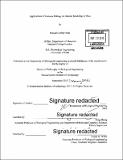| dc.contributor.advisor | Feng Zhang. | en_US |
| dc.contributor.author | Platt, Randall Jeffrey | en_US |
| dc.contributor.other | Massachusetts Institute of Technology. Department of Biological Engineering. | en_US |
| dc.date.accessioned | 2016-07-18T20:02:13Z | |
| dc.date.available | 2016-07-18T20:02:13Z | |
| dc.date.copyright | 2015 | en_US |
| dc.date.issued | 2016 | en_US |
| dc.identifier.uri | http://hdl.handle.net/1721.1/103695 | |
| dc.description | Thesis: Ph. D., Massachusetts Institute of Technology, Department of Biological Engineering, February 2016. | en_US |
| dc.description | Cataloged from PDF version of thesis. "September 2015." | en_US |
| dc.description | Includes bibliographical references (pages 60-66). | en_US |
| dc.description.abstract | The genome holds the blueprint of life and heredity. In the case of the mammalian genome it is comprised of billions of DNA bases grouped into elements that we are beginning to understand (ie genes) and others we know little about (ie noncoding DNA). Forward and reverse genetics in cells and animal models is key to discovering causal mechanisms relating molecular and genetic events to phenotypes. Therefore, the ability to sequence and edit DNA is fundamental to understanding of the role of genetic elements in normal biology and disease. Recently developed genome editing technologies are now making it possible to modify the genome in its endogenous context, opening up exciting possibilities for understanding its function. The RNA-guided endonuclease Cas9 from microbial type II CRISPR (clustered regularly interspaced short palindromic repeat) systems has been harnessed to facilitate facile genetic manipulations in a variety of cell types and organisms. Cas9 can be easily reprogrammed using RNA guides to generate targeted DNA double strand breaks, which can stimulate genome editing. A unique advantage of the Cas9 system is that Cas9 can be combined with multiple guide RNAs to achieve efficient multiplexed genome editing in mammalian cells, which opens up the possibility of interrogating multigenic biological processes. In this thesis, we utilize the Cas9 technology to facilitate genome editing experiments in vivo in mice. First, we create a Cas9 knockin mouse and demonstrate its utility for in vivo and ex vivo genome editing experiments. Then, we leverage the Cas9 knockin mouse and viral-mediated delivery of guide RNA to model lung adenocarcinoma to obtain pathology consistent with traditional transgenic mouse models and human patients. Finally, we utilize pronuclear injection of Cas9 mRNA and guide RNA to generate mice harboring a mutation in the autism-associated gene CHD8 and investigate the underlying behavioral and molecular phenotype. These applications broadly demonstrate the potential of Cas9 for interrogating genetic elements in vivo towards understand their role in normal biological processes and disease. | en_US |
| dc.description.statementofresponsibility | by Randall Jeffrey Platt. | en_US |
| dc.format.extent | 102 pages | en_US |
| dc.language.iso | eng | en_US |
| dc.publisher | Massachusetts Institute of Technology | en_US |
| dc.rights | MIT theses are protected by copyright. They may be viewed, downloaded, or printed from this source but further reproduction or distribution in any format is prohibited without written permission. | en_US |
| dc.rights.uri | http://dspace.mit.edu/handle/1721.1/7582 | en_US |
| dc.subject | Biological Engineering. | en_US |
| dc.title | Applications of genome editing for disease modeling in mice | en_US |
| dc.type | Thesis | en_US |
| dc.description.degree | Ph. D. | en_US |
| dc.contributor.department | Massachusetts Institute of Technology. Department of Biological Engineering | |
| dc.identifier.oclc | 953189086 | en_US |
